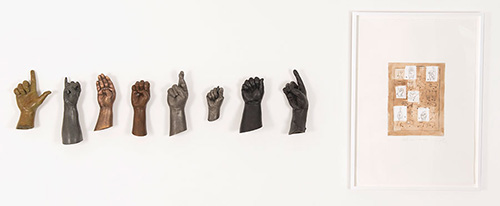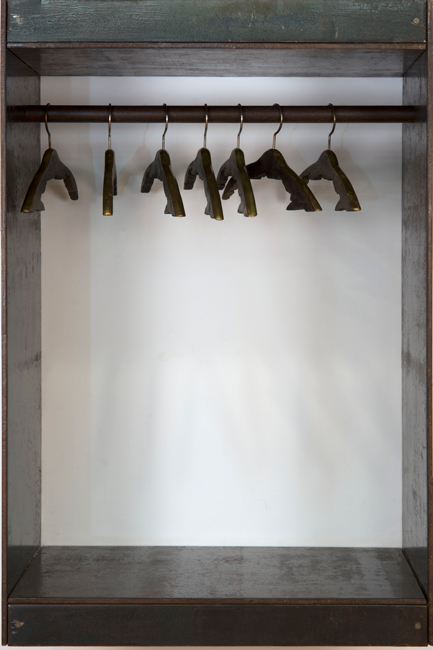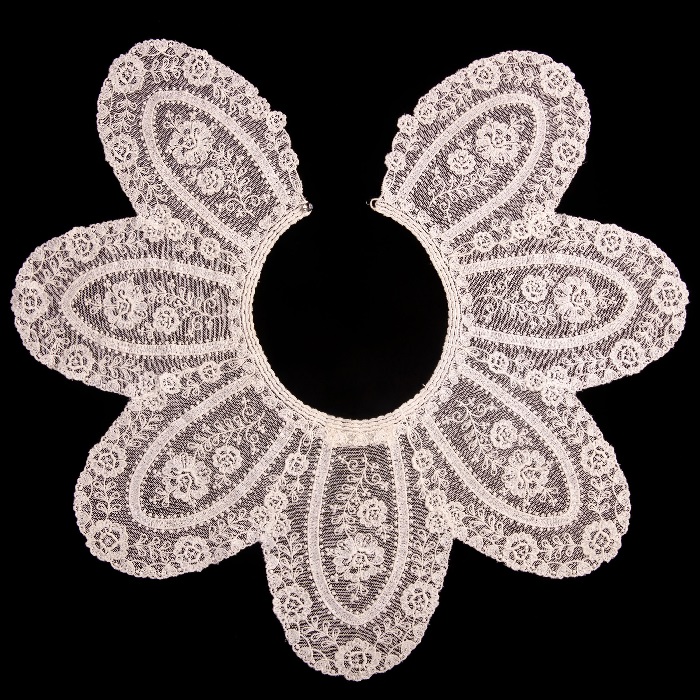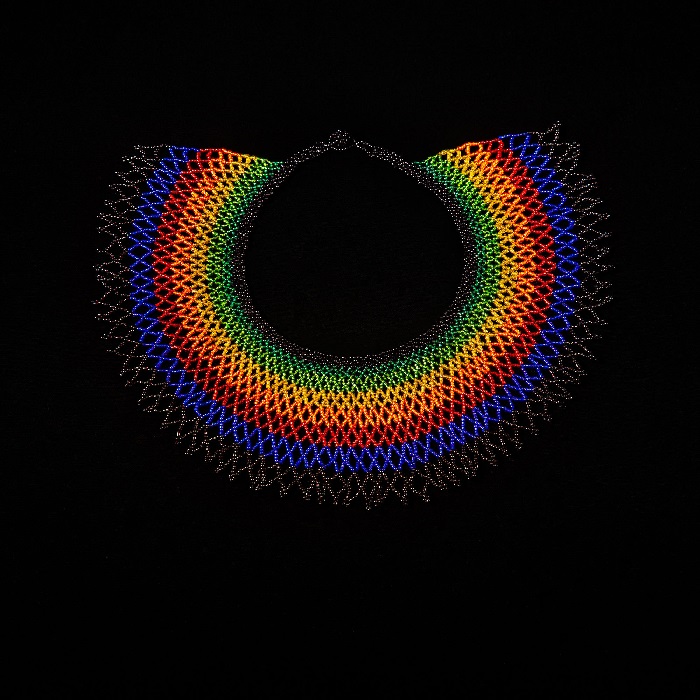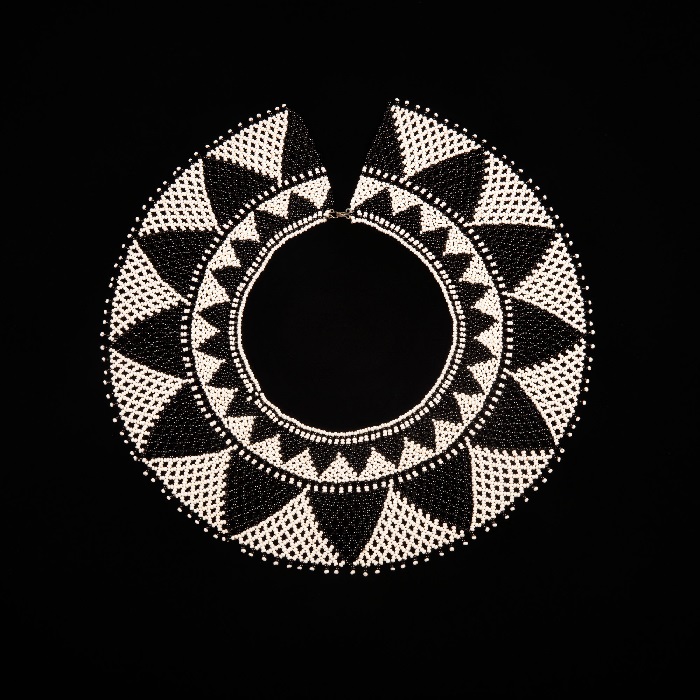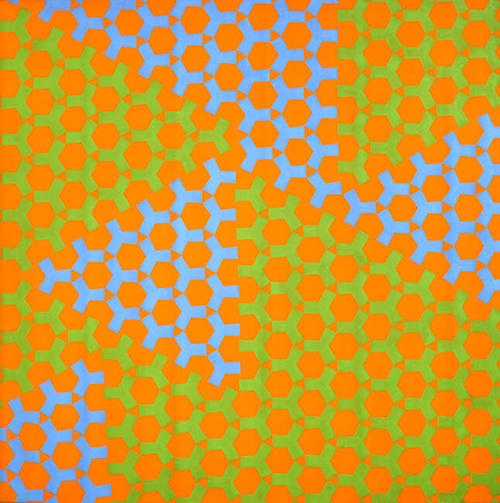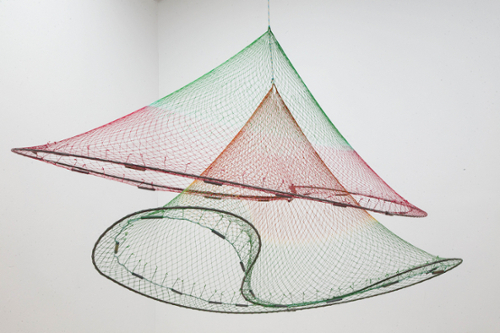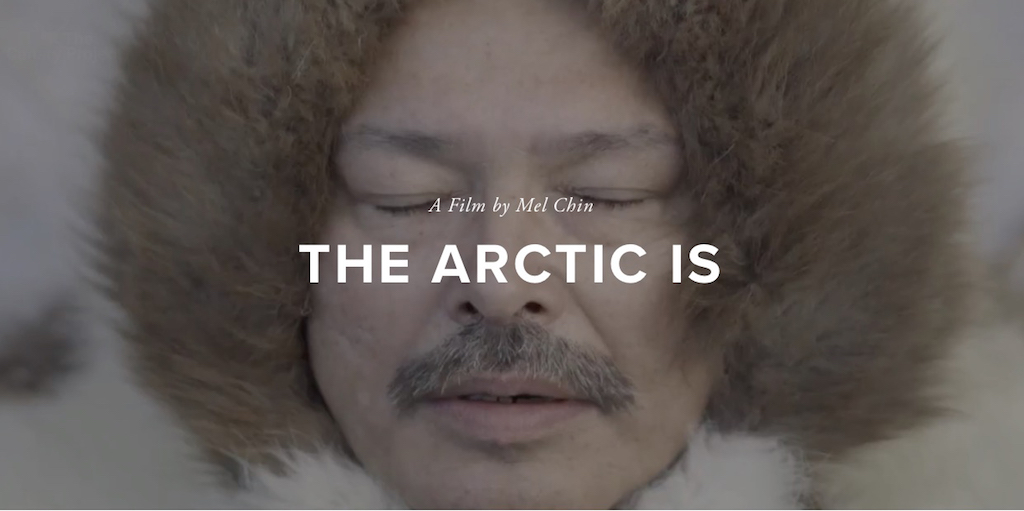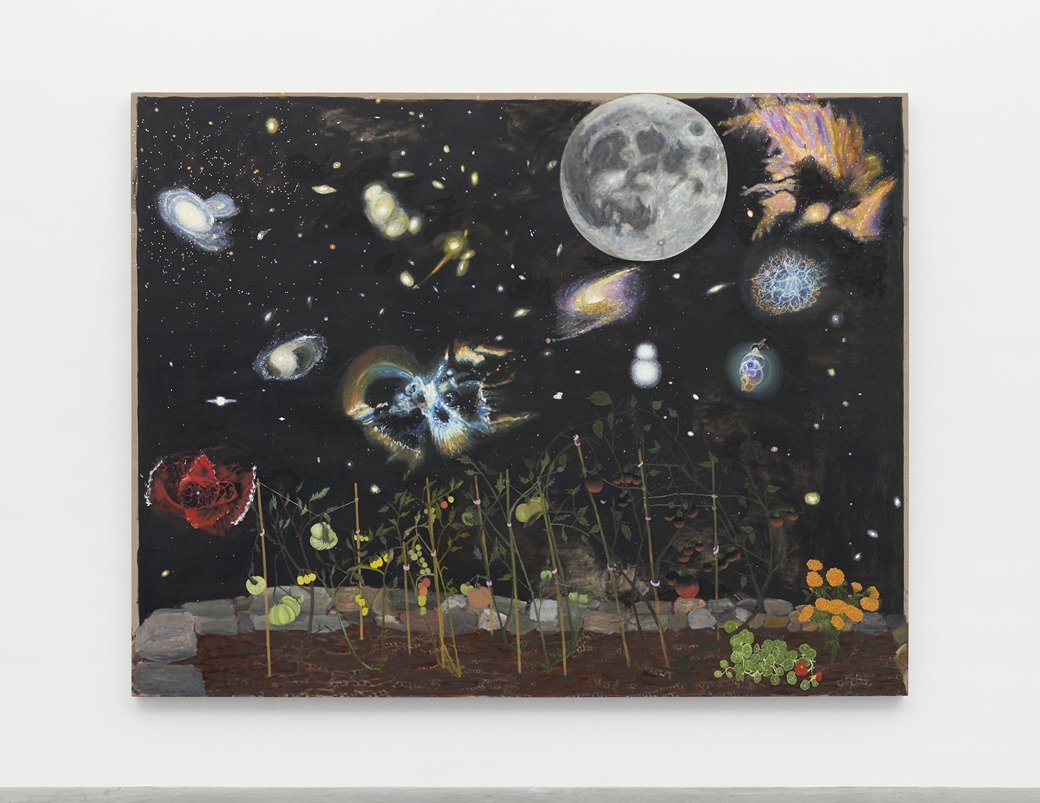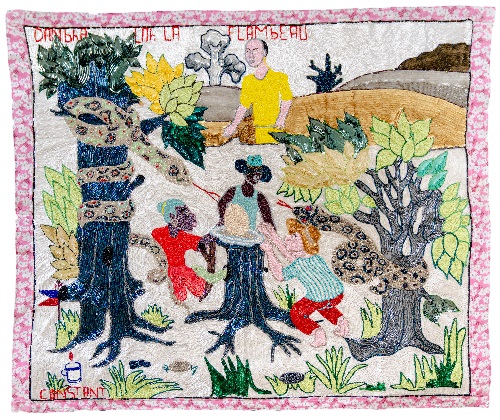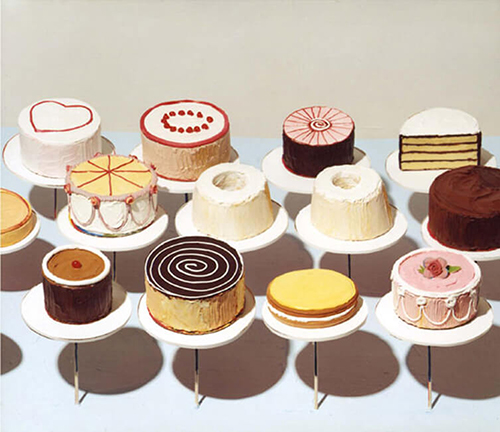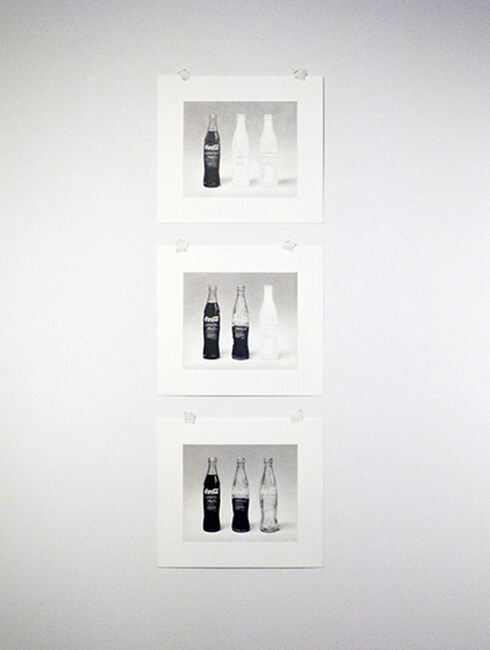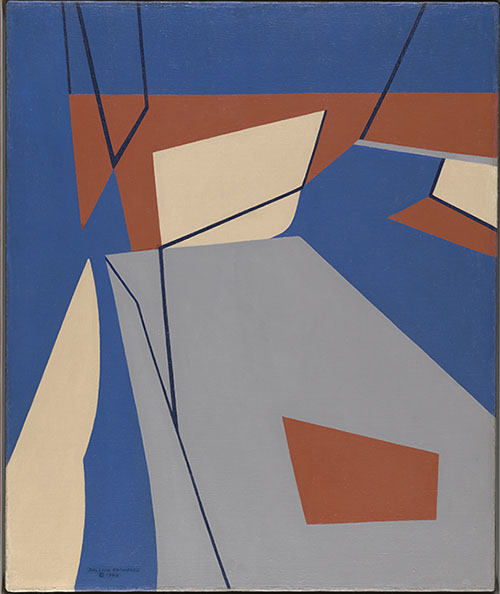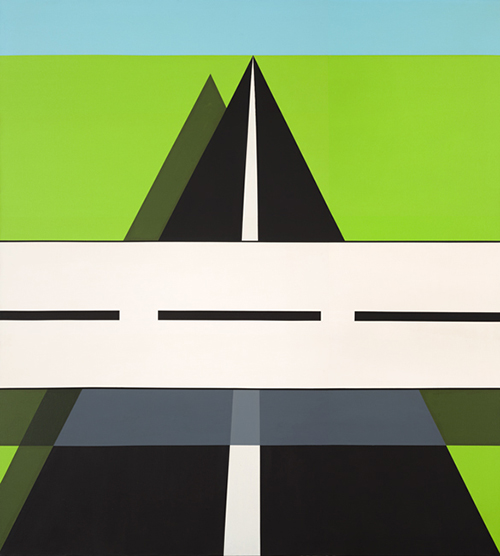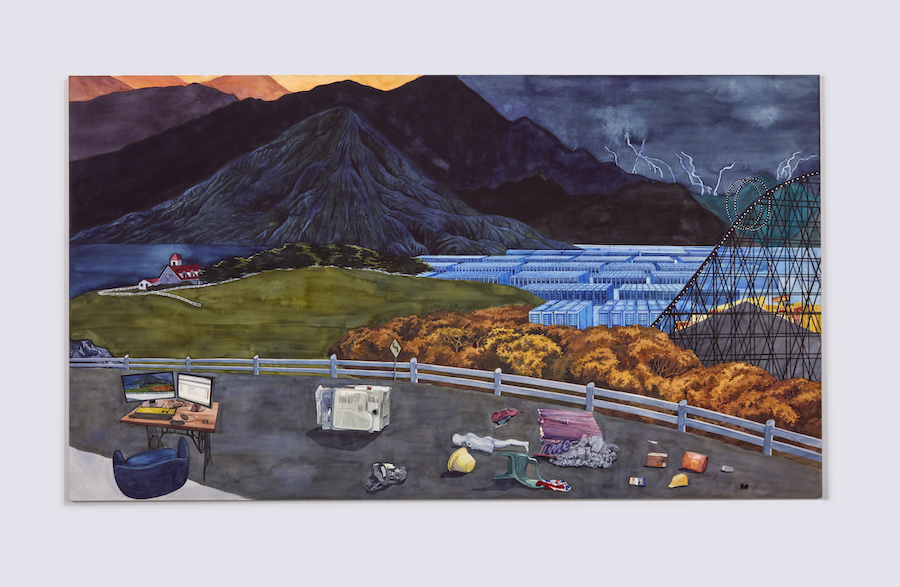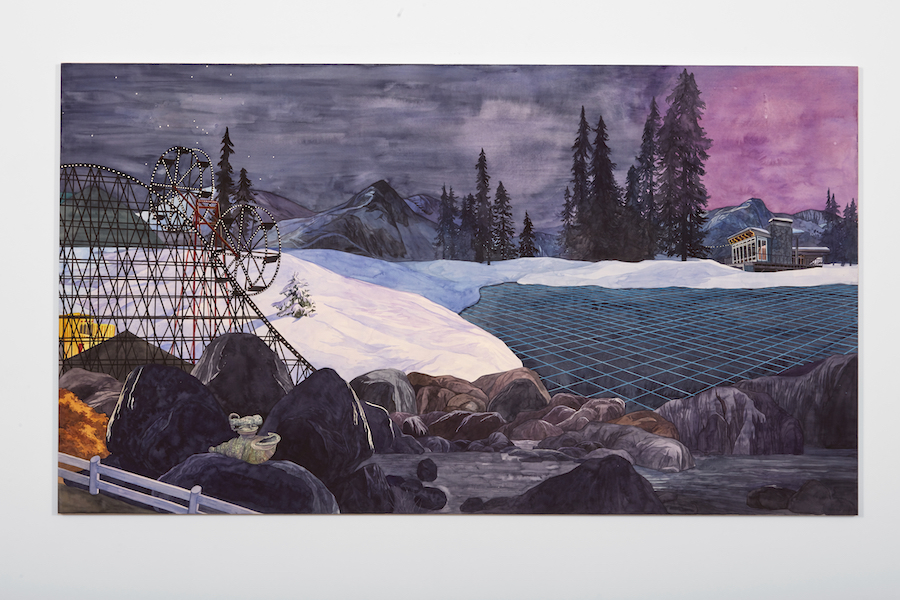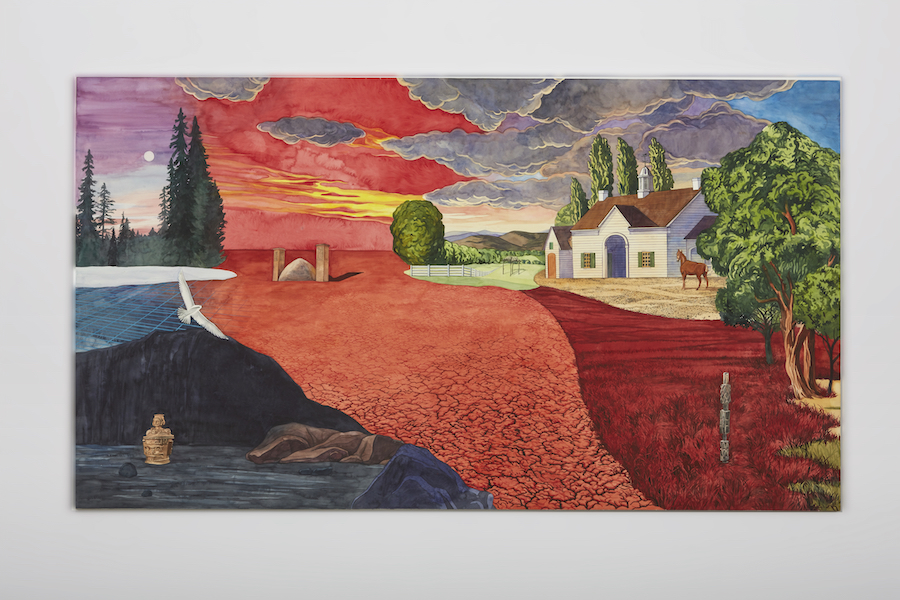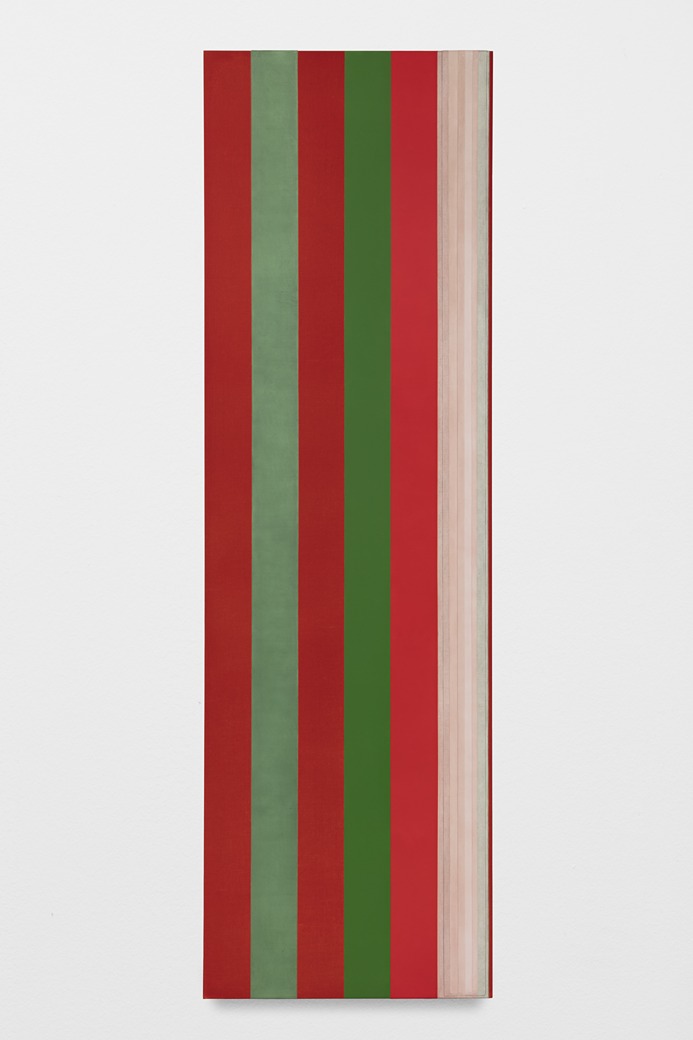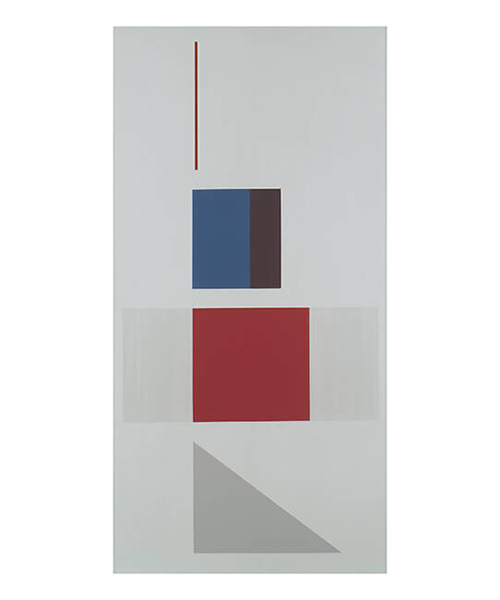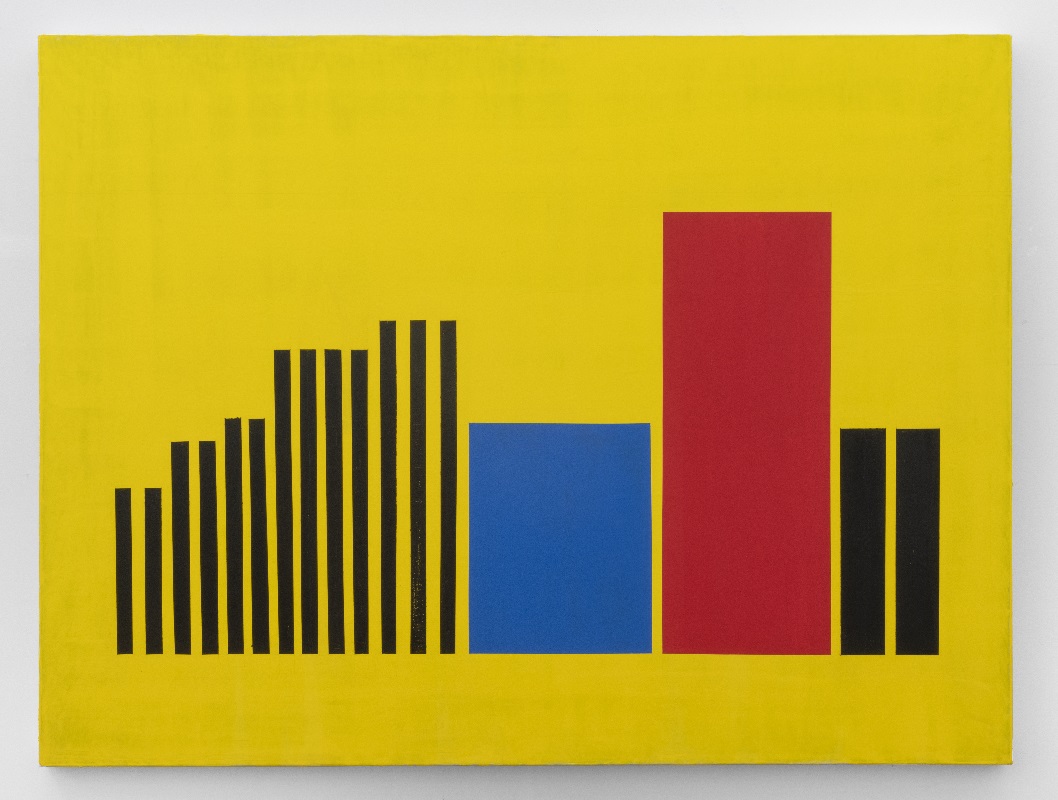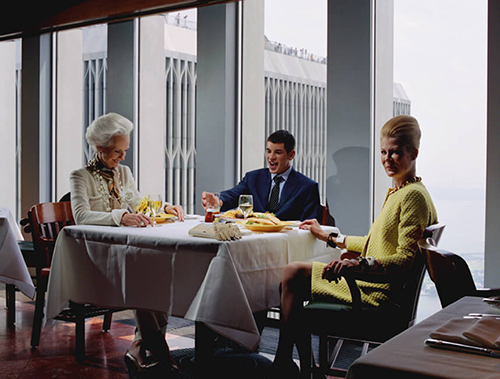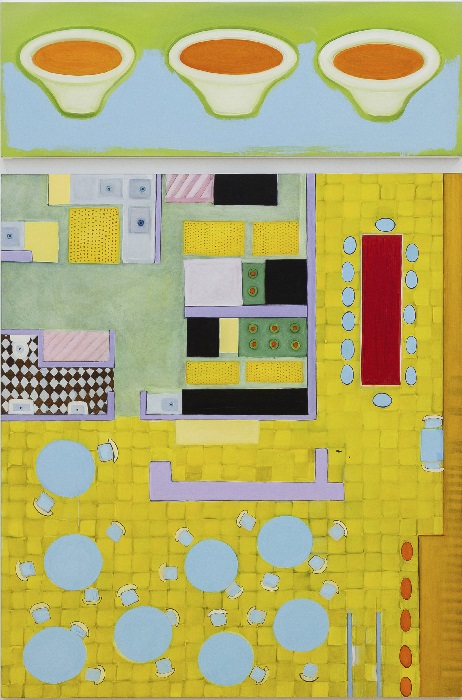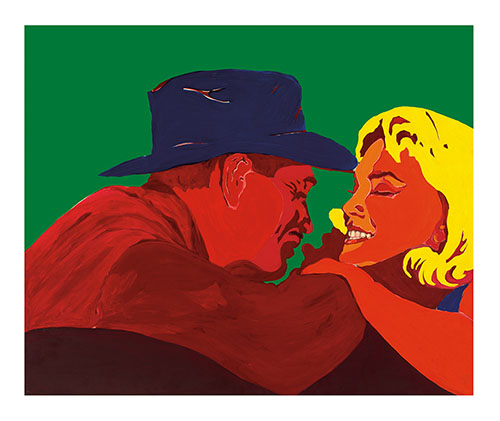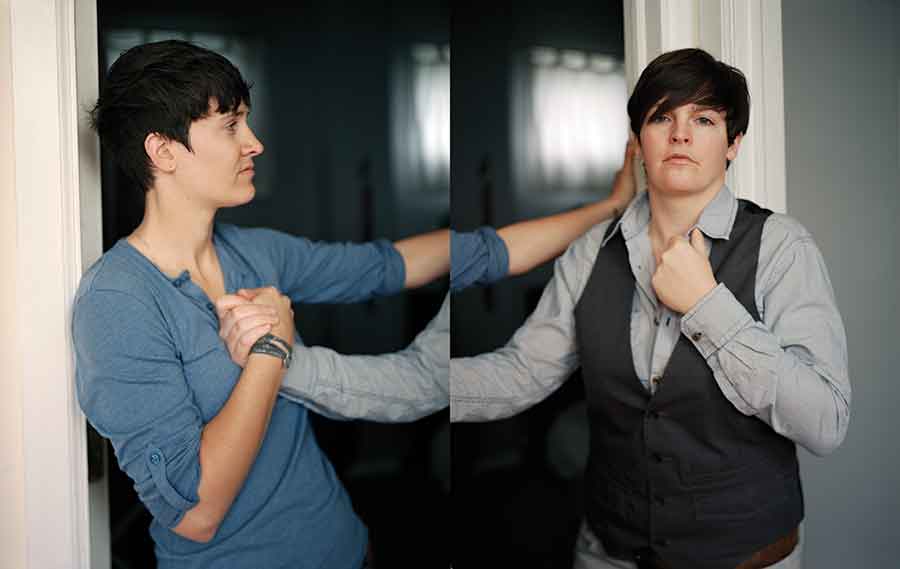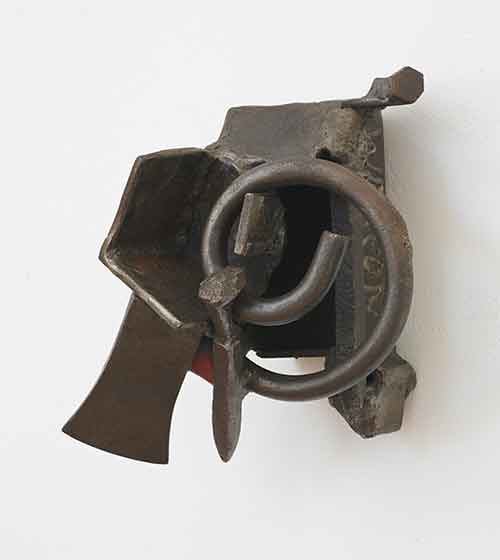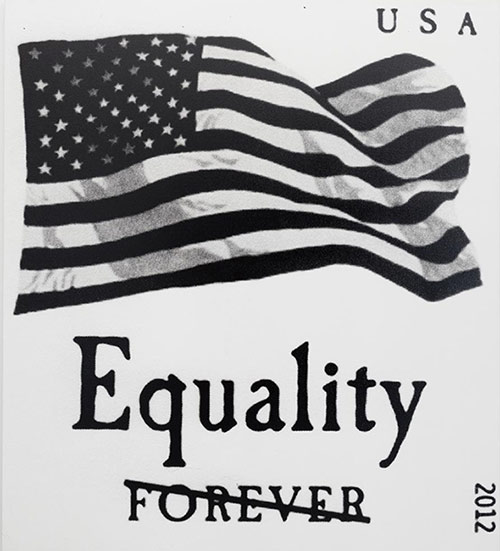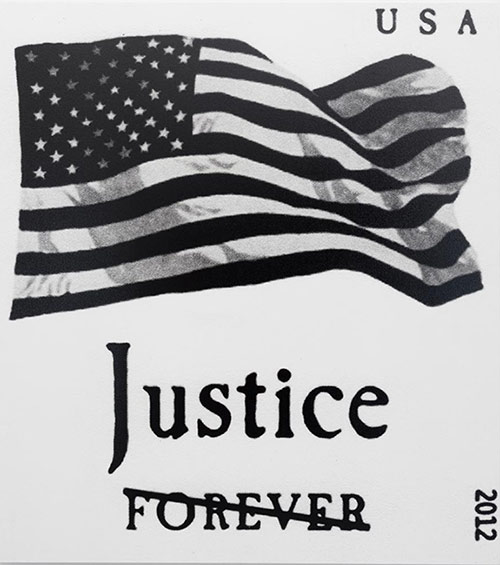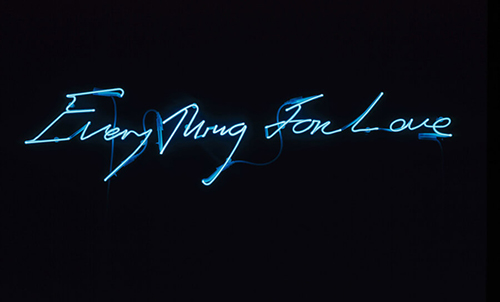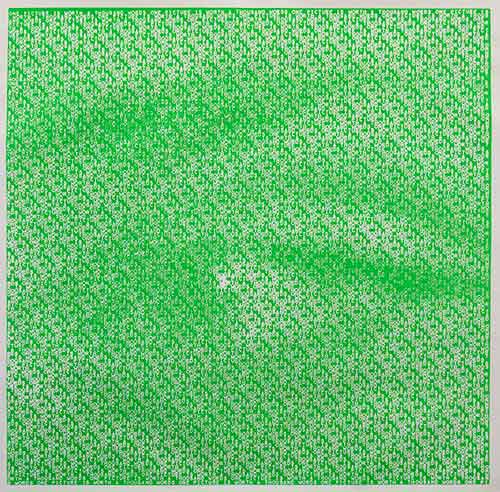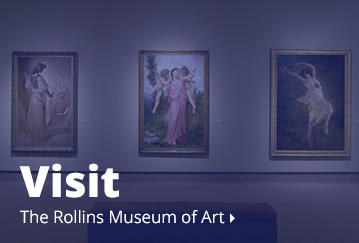Alfond Collection: Artists C-E
From María Magdelena Campos-Pons to Experiments in Arts and Technology (E.A.T.), explore the works of artists C-E in the Alfond Collection of Contemporary Art.
PLEASE NOTE: Not all works in the Rollins Museum collection are on view at any given time. View our Exhibitions page to see what's on view now. If you have questions about a specific work, please call 407-646-2526 prior to visiting.
Artists Featured in This Section
María Magdalena Campos-Pons
(Cuban, b. 1959)A Prayer for Obama, 2008-14
Pigmented UltraChrome K3 ink prints
32 1/2 x 25 in.
The Alfond Collection of Contemporary Art, Gift of Barbara '68 and Theodore '68 Alfond, 2015.1.3. © María Magdalena Campos-Pons.
Conceptual artist María Magdalena Campos-Pons works in a variety of mediums—photography, painting, installation, film, and performance—to create layered works inspired by personal and cultural memories. She states, “My subjects are often my Afro-Cuban relatives as well as myself. My themes are cross cultural, and cross generational; race and gender expressed in symbols of matriarchy and maternity are thematic ideas.” Here, history, memory, and the present converge to record the artist’s experience of the day Barack Obama first won the 2008 presidential election. Through this series of photographs, she recalls Santería traditions, a religious practice she finds intrinsically tied to the traditions of oppressed people and engages in a ritual to protect Obama. Her gestures are expressive and intentional. In the center panel, her devotional pose cradles a puppet of Obama in her hands and instills feelings of hope. Santería incorporates Catholicism and African spiritual practices.
Yoan Capote
(Cuban, b. 1977)Abstinencia (Libertad), 2014
Cast bronze and engraving and drypoint
Dimensions variable
The Alfond Collection of Contemporary Art, Gift of Barbara '68 and Theodore '68 Alfond, 2014.1.39. © Yoan Capote. Image courtesy of the artist and Jack Shainman Gallery, New York
Yoan Capote’s sculptures poignantly depict how bodies can reflect—and resist—the weight of “what cannot be said.” Over the past decade he has become internationally known for creating concise material metaphors for the complex limits on personal and public expression that specifically impact his life in Havana, Cuba, and in a universal sense, affect all of us. An exceptional draftsman and carver, Capote will often focus on mouths, ears, hands—each body part conceptually stands for the whole exchange of civil discourse and being heard. For example, his 2004–12 sculpture series Stress compresses rows of cast human teeth under stacked concrete cubes to suggest the tortuous difficulty of speaking out against improbable pressures. And his 2007–8 installation Mass Portrait (lot) assembles a group of rough-cut stones with life-like ears carved on either side, marking otherwise unidentifiable individuals who have no mouths to respond to what they hear. Yet in each case, Capote’s hefty figures are imbued with stony, obdurate strength. They do not collapse.
Begun in 2011 and first exhibited in Havana, Capote’s series Abstinencia introduces critically coded and collective gestures that defy such social restraint and complicit self-silence. He cast in various bronze patinas the hands of anonymous Cubans as they formed letters in sign language, and then sequenced them to spell out meaningful words: política, religión, economía. Capote defines each as “an ironical expression of the ordinary person’s lack of any voice or social decision-making power with regard to [such] key contemporary issues,” whether in Castro’s Cuba or beyond.[1] Capote subsequently expanded the project to include terms never exhibited in Cuba: democracia and libertad. Within the series, Abstencia (Libertad) is the only part created in the United States—in this case, commissioned specifically for the Alfond Collection of Contemporary Art—and speaks to the unique complexities of a nation that holds “liberty” in ultimate esteem. Created from the hands of Latino immigrant laborers in a foundry in New York, Libertad maintains the series’ critical resonance but shifts its focus to ask: What is abstinent, absent, or unsaid here? Is true liberty lacking for the laborers whose hands are cast? When parts represent the whole, the metaphor is called a synecdoche, from the Greek for “simultaneous understanding.” Here the parts of Capote’s Libertad invite us to simultaneously feel the strain between personal aspiration and a national ideal.
--Jen Mergel
[1] See http://yoan-capote.com/en/artworks/sculpture-installations/abstinence-politics. In a conversation with the author on June 8, 2014, Capote clarified that the “work is not only about the Cuban government.”
Yoan Capote
(Cuban, b. 1977)La ausencia (escuchando el vacio) / The absence (listening to the void), 2011
Bronze, steel
43 1/4 x 28 3/4 x 19 5/8 in.
The Alfond Collection of Contemporary Art, Gift of Barbara '68 and Theodore '68 Alfond, 2017.6.1. © Yoan Capote. Image courtesy of the artist and Jack Shainman Gallery, New York
Yoan Capote was born in Pinar del Rio, Cuba in 1977—a period of continued political complexity under Fidel Castro’s communist regime. Growing up seeing the sociological conditions and psychological states of everyday living in Cuba had a profound impact on Capote’s work as an artist, leading to an interest in exploring the connection between inanimate objects and the human psyche. In La ausencia (escuchando el vacío), Capote confronts the topic of control and desertion. Designed to look like a small wardrobe, the structure stands empty as a reminder of the void left behind by family members and friends that have fled Cuba in search of social, economic, and political freedom. The hangers reinforce the idea of absence, yet their inclusion makes it a tangible presence. Cast in bronze, the hangers are shaped in the outline of the island’s southern border. While this grounds the work in a specifically Cuban experience, the themes of abandonment, isolation, loss, and oppression resonate with the universal human condition. “One day, in a magazine, I read a sociologist saying that almost every Cuban family has an empty closet from someone who left the country. And I was sad about that, remembering that my mother had family that she never saw again.”
Elinor Carucci
(Israeli-American, b. 1971)Court Collar, 2020
Archival pigment print
12 x 12 in.
The Alfond Collection of Contemporary Art, Rollins Museum of Art. Gift of Barbara ’68 and Theodore ’68 Alfond. 2021.1.1 © Elinor Carucci
In 2020, Time magazine commissioned photographer Elinor Carucci to capture a selection of the distinctive collars worn by the late Supreme Court Justice Ruth Bader Ginsburg. The images accompanied the article "Portraits of Ruth Bader Ginsburg's Favorite Collars and the Stories Behind Them," by Tessa Berenson, which was published in November of 2020. Each of Carucci's photographs focuses on one of the collars; set against a dark background, the emblematic objects stand out as signifiers of the Justice’s progressive and feminist perspectives. Known popularly as “RBG,” Justice Ginsburg was only the second woman to sit on the U.S. Supreme Court. Her collars, often gifts from admirers, colleagues, or students, were encoded with layers of meaning that frequently related the cases she was working on. For instance, the Court Collar was one of her favorites to wear to court, and the Pride Collar, a gift from a fellow at Georgetown University Law Center, showed her unyielding support for the LGBTQ community. The South American Collar was the last one she wore, only a few weeks before she passed.
Elinor Carucci
(Israeli-American, b. 1971)Pride Collar (2016), 2020
Archival pigment print
12 x 12 in.
The Alfond Collection of Contemporary Art, Rollins Museum of Art. Gift of Barbara ’68 and Theodore ’68 Alfond. 2021.1.2 © Elinor Carucci
In 2020, Time magazine commissioned photographer Elinor Carucci to capture a selection of the distinctive collars worn by the late Supreme Court Justice Ruth Bader Ginsburg. The images accompanied the article "Portraits of Ruth Bader Ginsburg's Favorite Collars and the Stories Behind Them," by Tessa Berenson, which was published in November of 2020. Each of Carucci's photographs focuses on one of the collars; set against a dark background, the emblematic objects stand out as signifiers of the Justice’s progressive and feminist perspectives. Known popularly as “RBG,” Justice Ginsburg was only the second woman to sit on the U.S. Supreme Court. Her collars, often gifts from admirers, colleagues, or students, were encoded with layers of meaning that frequently related the cases she was working on. For instance, the Court Collar was one of her favorites to wear to court, and the Pride Collar, a gift from a fellow at Georgetown University Law Center, showed her unyielding support for the LGBTQ community. The South American Collar was the last one she wore, only a few weeks before she passed.
Elinor Carucci
(Israeli-American, b. 1971)South American Collar: the last collar Ginsburg wore in her lifetime, at a wedding she officiated on August 30, 2020, 2020
Archival pigment print
12 x 12 in.
The Alfond Collection of Contemporary Art, Rollins Museum of Art. Gift of Barbara ’68 and Theodore ’68 Alfond. 2021.1.3 © Elinor Carucci
Born in Jerusalem, Israeli American artist Elinor Carucci began experimenting with the photographic medium and at young age. Her work often explores issues of identity, motherhood, and intimacy, exploring the personal and social dimensions of these spheres. Shortly after the death of Justice Ruth Bader Ginsburg, in September of 2020, Time magazine commissioned Carucci to photograph Justice Ginsburg’s famous collars. Without a human subject, these images speak to the larger-than-life presence of the Justice in her 27 years of service to the higher court and to her impactful legacy. As the second female to sit on the U.S. Supreme Court, Ginsburg moved progressive ideals forward in both the judicial and sociopolitical arenas. She was the first Supreme Court Justice to officiate a same-sex wedding in 2013 and was part of the 2015 majority vote to extend same-sex couples the fundamental right to marry, making same-sex marriage legal nationwide. Part of a larger series, these works celebrate Ginsburg’s fight for equal rights for women and for the LGBTQ+ community. Photographed on a flat, black background, each of these images highlights the life and work of Justice Ginsburg and serves as an invitation to viewers to consider the current, fragile state of women’s rights in America.
Jordan Casteel
(American, b. 1989)Shirley (Spa Boutique2go), 2018
Oil on Canvas
78 x 60 in.
The Alfond Collection of Contemporary Art, Gift of Barbara ’68 and Theodore ’68 Alfond. 2018.1.25 ©Jordan Casteel
After receiving a residency at the Studio Museum in Harlem, Casteel shifted her creative output from rendering male nudes posed in domestic interiors, to nuanced portraits of people she met on the streets of her new neighborhood. Casteel’s works become very personal as she captures the daily life of her subjects. She connects and empathizes with the people that she paints and in turn, they become part of one another’s lives. In her paintings, she pays particular attention to the hues and tones that create one’s skin tone. Her figures glow with variations in colors, which empathizes their individuality. This work depicts Shirley, Casteel’s “wonderful Harlem masseuse,” in vivid hues of yellow and pink. Her direct gaze gives the viewer an opportunity for introspection and reflection on identity and representation. Casteel lives and works in New York and is a recipient of the prestigious MacArthur Foundation Grant (2021).
Rosemarie Castoro
(American, 1939 - 2015)Green Blue Orange Y, 1965
Acrylic on canvas
84 x 84 in.
The Alfond Collection of Contemporary Art, Gift of Barbara '68 and Theodore '68 Alfond, 2014.1.20. © Rosemarie Castoro. Image courtesy of the artist and Broadway 1602.
While a student at Brooklyn’s Pratt Institute, Rosemarie Castoro studied graphic design and printmaking, but was also an active member of the school’s modern dance groups, working both as a performer and a choreographer. These experiences helped to inform her work on works such as this one, which she referred to as paintingscuptures. The letter Y became a kind of stand-in for the notation used by choreographers, reflecting her understanding of her work as dynamic rather than simply static. She achieved early recognition for this and similar works, exhibited with other artists under the general rubric of Minimalism in the 1960s. Minimalism, particularly as exemplified by artists like Carl Andre and Robert Morris, argued for the primacy of the materiality of the art object, rejecting biographical and other personal content in the artwork. Recent scholars, noting the ways in which this emphasis on pure materiality and suppression of biography has tended to privilege the works of male artists, in particular Andre (who was married to Castoro while the two were developing their Minimalist aesthetics), minimizing the contributions of Castoro and other women artists.
In the later 1960s and early 1970s Castoro continued to investigate her embodied, choreography-inflected interests, producing a series of drawings and Polaroid photographs that inventoried her daily movements and activities. This resulted in Paula Cooper Gallery Cracking, also known as Room Cracking #7 (1969) and a series of Street Works which blended performance, documentation, drawing, and sculpture. For the rest of her career Castoro continued to create intermedia works that interrogated the intersections of mind, body, performance, and mark-making.
Carolina Caycedo
(London-born Colombian, b. 1978)Karagabi, 2019
Two artisanal hand-painted fishing nets, lead weights, steel rod and rope
49 1/8 x 7 7/8 x 29 7/8 in.
The Alfond Collection of Contemporary Art, Gift of Barbara '68 and Theodore '68 Alfond, 2019.2.18. © Caroline Caycedo
Carolina Caycedo frequently investigates environmental justice, particularly the subject of water politics, through performance, film, installation, and sculpture. During her field research in Girardot, Colombia, a small town along the Magdalena River and a community drastically affected by the privatization of water, she began her series Cosmotarrayas - a combination of "cosmo" and atarraya," Spanish for "cast net." Caycedo constructed her sculptures from handmade fishing nets the artist bought from friends and local markets in the community. Then in her Los Angeles studio, she dyed them in vibrant colors and formed them to recall the diverse ways fishermen and women cast their nets. Thus, the sculptures embody individuals, their knowledge, and their instinctive bonds with the river. Through each sculpture the artist hopes viewers not only reflect on the personal loss and resilience of the Girardot community, but that they also reestablish their personal relationships to water, an invaluable resource worldwide.
Mel Chin
(American, b. 1951)The Arctic is Paris (L’arctique est Paris), 2015
Digital video
6 minutes and 35 seconds
The Alfond Collection of Contemporary Art, Gift of Barbara ’68 and Theodore ’68 Alfond. 2019.2.15 © Mel Chin
Leidy Churchman
(American, b. 1979)One Taste, 2020
Oil on linen
79 x 102 ½ in
The Alfond Collection of Contemporary Art, Rollins Museum of Art, Gift of Barbara ’68 and Theodore ’68 Alfond, 2021.1.18 © Leidy Churchman
Anne Collier
(American, b. 1970)Eye (Fluorescent Colors), 2007
C print
51 x 56 3/4 in.
The Alfond Collection of Contemporary Art, Gift of Barbara '68 and Theodore '68 Alfond, 2015.1.48. Image courtesy of the artist and Anton Kern Gallery, New York; Galerie Neu, Berlin; The Modern. © Anne Collier. Image courtesy of the artist and Anton Kern Gallery, New York; Galerie Neu, Berlin; The Modern Institute / Toby Webster LTD., Glasgow' and Marc Foxx Gallery, Los Angeles
Myrlande Constant
(Haitian, b. 1968)Damballah La Flambeau, 1995
Mixed media
42 1/2 x 46 1/2 in.
The Alfond Collection of Contemporary Art, Gift of Barbara ’68 and Theodore ’68 Alfond, 2022.2.12 © Myrlande Constant. Courtesy of the artist and Fort Gansevoort
Myrlande Constant was born in Port-au-Prince, Haiti, and was raised by her mother who worked in a dress-making factory. Constant later worked in the same factory, where she learned how to do beadwork, which she uses here to reimagine a traditionally male art form in Haiti—flag making. Inspired by the religion of Vodou, Constant creates elaborately beaded flags representing the religion’s stories and spirits. In this image the great magician spirit, Damballah, is represented by a snake. Traditionally, these flags were made by Vodou priests and their followers, who started the artform using sequins instead of beads. Here, the rhythmic lines of hand-sewn beads guide our gaze across the colorful terrain of the composition. Constant’s flag challenges viewers to rethink Western perceptions of Vodou celebrating the tradition instead of demonizing it, making the flag emblematic of both the significance of religion in her life and her agency as an artist.
Sharon Core
(American, b. 1965)Cakes, from the series Thiebaud, 2004
C-print
60 x 72 in.
The Alfond Collection of Contemporary Art, Gift of Barbara '68 and Theodore '68 Alfond, 2013.34.134. Image courtesy of the artist and Yancey Richardson Gallery, New York. © Sharon Core. Image courtesy the artist and Yancey Richardson Gallery
The manicured swirls of icing, delicate pink roses, and neatly placed cherries imbue the cakes in Sharon Core’s photograph with a delectable charm that would appeal to any sweet tooth. As if they were precious gems, the cakes rest on round pedestals supported by spindly stems. They look too good to be true, and this questioning of truth stands at the heart of Core’s practice. Examining the artist’s detailed, active creative process prompts an inquiry into the relationship between reality and representation and makes the delicacies in Cakes all the richer, even if only metaphorically.
Throughout her varied series, Core’s appropriation, investigation, and re-interpretation of source images invites viewers to question the ways in which the objects in her photographs are or are not “real.” She engages in a multi-step process that fuses painting, performance, and photography to construct a conceptual meditation on reality. Cakes is from a series in which Core drew inspiration from the works of Wayne Thiebaud, an American artist from the mid-twentieth century known for his dreamy, nostalgic paintings of cakes, candies, and other edible treats. In this case, Core borrows her subject, as well as the title, from Thiebaud’s Cakes (1963). In a performative exercise working from a photograph of the Thiebaud painting, Core baked, decorated, and arranged her own cakes, then utilized light and perspective to craft a replica of Thiebaud’s Cakes. More than copying the work, Core animates it, transforming representation into reality. However, in a gesture that subverts her previous actions, the artist then photographed her carefully constructed set, returning her subject to two-dimensionality. The cakes are transformed once again into a representation. Their reality remains distanced from the viewer, and Thiebaud’s original painting stands at an even further remove. Core blurs the line that separates what is true and tangible and what is reproduction.
Through the layers of representation at play, moreover, Core engages a long-standing discourse on art’s ability to accurately depict reality. While a traditional goal of painting has been to create a window onto the world, photography has historically been regarded as a document of or testament to truth. In Cakes, however, Core collapses these media. Her works suggest that both are capable of inventing realities. Just as Thiebaud can employ impasto to imitate the lushness of frosting, so too can Core manipulate light and composition to mimic a painting. Core’s work serves as a reminder not to accept an image at face value, but rather to reflect on its veracity.
--Laura Beshears
Martí Cormand
(Spanish, b. 1970)Formalizing Their Concept: Cildo Meireles' "Insertions Into Ideological Circuits: Coca Cola Project" 1970, 2012
Graphite and oil
13 x 14 1/2 in.
The Alfond Collection of Contemporary Art, Gift of Barbara '68 and Theodore '68 Alfond, 2013.34.64. Image courtesy of the artist and Josée Bienvenu Gallery, New York.
Since the late 1990s, Martí Cormand has been making paintings and drawings that address the nature of representation in the digital age and the ephemerality––or endurance––of physical materials. Often working in series, he applies the same precision and attention to detail whether he is working with paint or more unconventional media, such as cardboard and packaging materials.
In the series Formalizing their concept, Cormand surveys the landscape of contemporary art and re-conceives other artists’ work. Reflecting on Conceptual artists of a previous generation, he meticulously reproduces their iconic pieces in graphite and oil on paper. Cormand includes a range of international artists, such as American Lawrence Weiner, Brazilian Cildo Meireles, and Belgian Marcel Broodthaers, reflecting the international reach of Conceptual art during the 1970s. Cormand employs a detached, documentary approach in his photorealist renderings of these works.
In revisiting these now-historical pieces, Cormand reflects on how they are currently understood and framed. He does so by returning to graphite and oil—the very conventional media these artists sought to undermine. The idea of “formalizing” suggested by his titles implies a re-institutionalization of Conceptual art within traditional media.
--Martina Tanga
Martí Cormand
(Spanish, b. 1970)Formalizing Their Concept: Lawrence Weiner's "A translation From One Language to Another" 1969, 2012
Graphite and oil
13 x 15 1/2 in.
The Alfond Collection of Contemporary Art, Gift of Barbara '68 and Theodore '68 Alfond, 2013.34.65. Image courtesy of the artist and Josée Bienvenu Gallery, New York.
In Lawrence Weiner’s “A translation from one language to another” 1969 (2012), he depicts Weiner’s stenciled “statement” in its original installation. The sentence sits flatly in Cormand’s painting just as it floats frontally on the wall, in contrast to the receding diagonal lines of the gallery space. In Cildo Meireles’ “Insertions Into Ideological Circuits: Coca-Cola Project” 1970 (2012), Cormand refers to an iconic intervention in which Meireles shows three Coca-Cola bottles––the first one full, the second half full, and the last empty––in order to explore the notion of circulation and exchange of goods. Cormand presents the motif in three different paintings, altering the original by depicting certain bottles as spectral apparitions, their form created by the faintest lines of graphite and oil.
Holly Coulis
(Canadian, b. 1968)Two Tables, Oranges, Cherry Cola, 2017
Oil on linen
40 x 47 63/64 in.
The Alfond Collection of Contemporary Art, Gift of Barbara '68 and Theodore '68 Alfond, 2017.6.55. Image courtesy of the artist.
Ralston Crawford
(American b. Canada, 1906-1978)Havana Harbor #3, 1948
Oil on Canvas
36 1/4 x 30 21/64 in.
The Alfond Collection of Art, Gift of Barbara '68 and Theodore '68 Alfond, 2017.15.2. Art © Estate of Ralston Crawford/Licensed by VAGA, New York
Allan D'Arcangelo
(American, 1930-1998)Landscape, 1967
Acrylic on canvas
60 x 54 in.
The Alfond Collection of Contemporary Art, Gift of Barbara '68 and Theodore '68 Alfond, 2018.1.3 © D’Arcangelo Family Partnership
Gabriel de la Mora
(Mexican, b. 1968)P., 2007
Hair on paper
13 1/4 x 10 3/4 x 2 in.
The Alfond Collection of Contemporary Art, Rollins Museum of Art. Gift of Barbara '68 and Theodore '68 Alfond, 2023.1.18 © Gabriel de la Mora
Gabriel de la Mora’s artistic practice is driven by meticulous experimentation with everyday materials. From discarded post-its to vintage photographs and rubber balls, the artist considers found objects, detritus, and physical elements as viable media to create works of art. Moving away from painting in 2004, de la Mora began using human hair to create lines and figures. This work is part of a series in which each portrait is made with the sitter’s hair, reflecting the individual's characteristics and containing their DNA. For the artist, these works question portraiture as a genre and challenge the boundaries between painting and drawing: “What looks like a painting wasn’t made by the human hand, but by the destruction of something over time. That unmaking or the remainder that has been marked by some action or piece of information can be reestablished or reconstructed in order to make an artwork.”
Danielle Dean
(British-American, b. 1982)11 p.m., 2022
Watercolor on paper mounted on dibond
48 x 85 in.
The Alfond Collection of Contemporary Art, Rollins Museum of Art. Gift of Barbara '68 and Theodore '68 Alfond, 2023.1.10. Image courtesy of the artist and 47 Canal, New York. Photo: Sara Pooley
Danielle Dean
(British-American, b. 1982)2:05 a.m., 2022
Watercolor on paper mounted on dibond
48 x 85 in.
The Alfond Collection of Contemporary Art, Rollins Museum of Art. Gift of Barbara '68 and Theodore '68 Alfond, 2023.1.11. Image courtesy of the artist and 47 Canal, New York. Photo: Sara Pooley
Danielle Dean
(British-American, b. 1982)5:10 a.m., 2022
Watercolor on paper mounted on dibond
48 x 85 in.
The Alfond Collection of Contemporary Art, Rollins Museum of Art. Gift of Barbara '68 and Theodore '68 Alfond, 2023.1.12. Image courtesy of the artist and 47 Canal, New York. Photo: Sara Pooley
Danielle Dean
(British-American, b. 1982)12:45 p.m., 2022
Watercolor on paper mounted on dibond
48 x 85 in.
The Alfond Collection of Contemporary Art, Rollins Museum of Art. Gift of Barbara '68 and Theodore '68 Alfond, 2023.1.13. Image courtesy of the artist and 47 Canal, New York. Photo: Sarah Pooley
Danielle Dean
(British-American, b. 1982)5 p.m., 2022
Watercolor on paper mounted on dibond
48 x 85 in.
The Alfond Collection of Contemporary Art, Rollins Museum of Art. Gift of Barbara '68 and Theodore '68 Alfond, 2023.1.14. Image courtesy of the artist and 47 Canal, New York. Photo: Sara Pooley
Svenja Deininger
(Austrian, b. 1974)Untitled, 2021
Oil on linen
130 x 39 ¼ in.
The Alfond Collection of Contemporary Art, Gift of Barbara ’68 and Theodore ’68 Alfond, 2021.1.25 Image courtesy of the artist and Marianne Boesky Gallery, New York and Spen. © Svenja Deininger.
David Diao
(American, b. 1943)Barnett Newman: The Unfinished Painting, 2013
Acrylic on canvas
78 x 38 19/32 in.
The Alfond Collection of Contemporary Art, Gift of Barbara '68 and Theodore '68 Alfond, 2014.1.22. Image courtesy of the artist and Office Baroque, Brussels.
At first glance, David Diao’s painting appears to obey the tenets of modernism: flat, autonomous, non-referential. Geometric shapes align along a central axis against a monochromatic background, without depth or illusion. Yet the very title belies these attributes. With Barnett Newman: The Unfinished Paintings, Diao uses specific referents to shift the painting’s register from abstraction to representation. Thanks to the title, rather than seeing independent forms set on a solid ground, we read the painting’s elements as a selection of canonical abstract expressionist painter Barnett Newman’s late works. The title transforms the image into a neatly ordered modernist cabinet of curiosities. It represents a collection of fragments that speak to the history of painting, a medium that Diao describes as having been in “perpetual crisis.”
Diao started his Barnett Newman series in 1990. He admired the artist for his intellectual take on abstract expressionism. Newman sought to create a painting that could convey pure presence. Solid fields of color, interrupted by “zips” or vertical stripes, would call out directly to the viewer. Diao, part of the generation of painters that came after Newman, is less convinced of painting’s ability to speak for itself. His work has, in various ways, served as a commentary on the history of painting. Other series address the works of Kazimir Malevich, Kostantin Melnikov, and in several self-referential pieces, Diao’s own work. In Home Again (2013), Diao tracks the path of one of his paintings through the art market. He documents its plummeting price after the first owners sold it without a reserve, and Diao’s repurchasing of the painting later on. This frank acknowledgment of the business of art is typical of postmodernism, but Home Again, like Barnett Newman: The Unfinished Paintings, lacks the cynicism so often found in postmodernist practice.
Diao admits that his paintings could be understood as “inside jokes,” yet their strong formal arrangements speak for themselves. By keeping two opposing modalities of painting—abstraction and representation—in tension, Diao creates visually compelling works that only become richer once their context is known.
--Kelly Presutti
David Diao
(American, b. 1943)Red Blue Chair Unassembled, 2020
Acrylic on canvas
The Alfond Collection of Contemporary Art, Rollins Museum of Art. Gift of Barbara ’68 and Theodore ’68 Alfond. 2020.1.12 © David Diao
Philip-Lorca DiCorcia
(American, b. 1951)W, September 2000, #6, 2000
Archival pigment print
32 x 42 in.
The Alfond Collection of Contemporary Art, Gift of Barbara '68 and Theodore '68 Alfond, 2013.34.31. © Philip-Lorca DiCorcia. Image courtesy of the artist and David Zwirner, New York/London
Philip-Lorca diCorcia’s photographs are not the informal snapshots they appear to be. By the time diCorcia began working in the early 1980s, photography was at last considered an artistic medium on a par with other fine-art categories. With his meticulously crafted and preconceived images, rendered with a signature style of lighting, composition, and presentation of subjects, diCorcia breached the delta between the real and the produced. His sensitivity to the confusion of fact and fiction made him the ideal collaborator for W magazine, as his treatment of people and places paralleled the hyper-real/fantastical vernacular common to fashion magazine spreads.
At first, diCorcia’s most frequent subject was his family and friends captured in fictional interior tableaus. He then began to photograph pedestrians in places like Hollywood and New York, an approach he pursued throughout the late 1980s and ’90s. In these and other works, diCorcia presents fragmented narratives that rely on the tension between the casual and the posed, and the unforeseen and the fated, all accentuated by distinctive lighting methods that have been compared to those of Baroque painters such as Caravaggio and Rembrandt. Almost always a blend of natural and artificial, his illumination activates his scenes.
In W, September 2000 #6 (2000), one of a series of eleven works diCorcia created for W magazine between 1997 and 2008, two ladies dine with a young man. What appears to be a stark, harshly lit environment on closer inspection is revealed to be the iconic restaurant of the World Trade Center in New York City. Now indelibly associated with the September 11, 2001, attacks, Windows on the World was once a place for power breakfasts and celebratory meals––a location loaded with social and cultural meaning. diCorcia’s characters have a veneer of propriety, but the tension in their exchange is highlighted by the image’s composition and intensely felt by the viewer. Despite their lively conversation in a purportedly perfect place, the figures appear isolated. In an interview with Lynne Tillman in 2007, diCorcia explained: “One thing I’ve tried to avoid . . . is nostalgia. It is one of the cheapest forms of content.” diCorcia spares nothing in his rigorous pursuit, through fiction, of a real kind of truth.
--Martina Tanga
Kim Dingle
(American, b. 1951)Tomato Bisque – Restaurant Mandala, 2012/2020
Oil on Canvas
90 1/4 x 60 1/8 in.
The Alfond Collection of Contemporary Art, Gift of Barbara ’68 and Theodore ’68 Alfond. 2020.1.26 © Kim Dingle
Born in Pomona, California, Kim Dingle explores in her work issues of gender, female childhood, personal experience, and myth. This painting is part of Dingle’s Restaurant Mandalas series created between 2012-2020. Combining elements of abstraction and figuration, the work speaks to the artist’s experience as a restaurant owner as well as to her artistic investigations into color and form. In 2003 Dingle paused her painting career to open a neighborhood restaurant, which she operated for ten years. This experience, including the daily food preparations and cleaning routines of the restaurant inform this piece. For her, the repetition of everyday tasks evokes a mandala’s contemplative quality. In this image we see the space from above; flat shapes of color conform the kitchen and dining areas, reducing them to their most elemental forms. The panel above presents a frontal perspective of three bowls of tomato bisque resting on the counter and ready to be served. While the piece exudes vibrancy in its colors and patterns, it signals a controlled, almost meditative experience.
Rosalyn Drexler
(American, b. 1926)The Misfits, 1961
Acrylic and paper collage on canvas
25 x 30 in.
The Alfond Collection of Contemporary Art, Gift of Barbara '68 and Theodore '68 Alfond, 2015.1.9. © Rosalyn Drexler/ Artists Rights Society (ARS), New York
Rosalyn Drexler’s source for this work is the 1961 movie The Misfits. The film, directed by John Huston, featured an acclaimed lineup: a screenplay by Arthur Miller and a cast including Montgomery Clift, Clark Gable, Marilyn Monroe, and Eli Wallach. Gable and Monroe, pictured here, played conflicted lovers, and for both famed actors this was to be their final completed film.
The Misfits belongs to a series of paintings by Drexler that present cinematic images. The artist’s do-it-yourself approach comes through in this work; she pasted a paper image of Monroe and Gable to the canvas and then rigorously painted over it. Drexler, drawn to film noir and crime movies, sometimes refers to specific films; in other cases her paintings are an amalgamation of different movie posters. This treatment heightens the psychological intensity present in The Misfits. The artist’s work has gained considerable attention in the last few years; however, there is more work to be done in casting her as a central figure. The art historical canon privileges men and singular narratives. As a result of the focus on artists like Andy Warhol (1928–1987), Drexler’s work has garnered less consideration, though it deserves a firm place in the narrative of Pop Art and more broadly in the history of twentieth-century American art.
Jess T. Dugan
(American, b. 1986)Erica and Krista, 2012
Pigment print
25 1/4 x 20 1/4 x 1 3/8 in.
The Alfond Collection of Contemporary Art, Gift of Barbara '68 and Theodore '68 Alfond, 2015.1.46. © Jess T. Dugan.
Jess T. Dugan is a photographer whose work largely focuses on members of the LGBTQ+ community. To depict the relationship between Erica and Krista, Dugan uses a diptych format which highlights each subject's individuality. The two photographs are intimately connected, however, by each of their hands reaching into the other’s space. It is no longer two separate portraits, but a unified composition sealed by the tight yet gentle grasp of their hands. Dugan depicts people with a variety of gender identities and sexual orientations, challenging the viewer to reflect on their own conceptions of identity. By revealing only the first name of the subjects and taking the pictures in personal spaces, such as their homes, Dugan encourages the viewer to connect with the subjects and look beyond their LGBTQ+ identity, seeing them as simply human.
Sam Durant
(American, b. 1961)Consider Listening, 2018
Screenprint on translucent film, light box
11 3/4 x 15 3/4 x 4 3/4 inches
The Alfond Collection of Contemporary Art, Gift of Barbara '68 and Theodore '68 Alfond, 2018.1.17. © 2018 Sam Durant, Image courtesy of Krakow Witkin Gallery, Boston.
Sam Durant
(American, b. 1961)Everyone Deserves a Dream, 2018
Screenprint on translucent film, light box
11 3/4 x 15 3/4 x 4 3/4 inches
The Alfond Collection of Contemporary Art, Gift of Barbara '68 and Theodore '68 Alfond, 2018.1.16. © 2018 Sam Durant, Image courtesy of Krakow Witkin Gallery, Boston.
Melvin Edwards
(American, b. 1937)Weapon of Freedom, 1986
Welded steel
11 x 9 x 6 in.
The Alfond Collection of Contemporary Art, Gift of Barbara '68 and Theodore '68 Alfond, 2014.1.58. © 2015 Melvin Edwards/Artists Rights Society (ARS), New York.
Born in Houston, Texas, Melvin Edwards learned to weld while an art student in Los Angeles, California. Responding to his involvement in anti-housing-discrimination protests and activism surrounding the shooting of Ronald Stokes by the LAPD, Edwards began making welded steel sculptures that he called Lynch Fragments. Originally, these sculptures were informed by his close study of African American history and anti-lynching literature and were meant to evoke both the danger and strength of African American life. Edwards moved away from the Lynch Fragments upon moving to New York in 1967, briefly revisiting the format in 1973 during a period of anti-Vietnam-war activism. He abandoned them again, however, believing that they required an obsessive devotion that crowded out other work. A 1978 retrospective exhibition at Harlem’s Studio Museum made him realize that he still had more to do with the series, however, and he has made Lynch Fragments ever since.
The Fragments are a unique sculptural form; neither fully in the round (they are always hung on gallery walls) nor fully relief, they also combine both identifiable found objects and abstract forms. In this one a railroad spike and ax head evoke the Weapon of the sculpture’s title while also calling back to African and African American blacksmithing traditions that Edwards gleaned from his family’s oral tradition as well as his extensive travels in Africa. The spiral form at the center helps to integrate the various forms while also creating a sense of tight compression that lends the piece an additional air of violent potential.
Gardar Einarsson
(Norwegian, b. 1976)Equality Forever, 2015
Silkscreen ink on canvas
53 x 48 in.
The Alfond Collection of Contemporary Art, Gift of Barbara '68 and Theodore '68 Alfond, 2015.1.51. © 2016 Gardar Eide Einarsson. Image courtesy of the artist and Team Gallery, Inc. New York and Los Angeles
Gardar Einarsson
(Norwegian, b. 1976)Justice Forever, 2015
Silkscreen ink on canvas
53 x 48 in.
The Alfond Collection of Contemporary Art, Gift of Barbara '68 and Theodore '68 Alfond, 2015.1.50. © 2016 Gardar Eide Einarsson. Image courtesy of the artist and Team Gallery, Inc. New York and Los Angeles
Nicole Eisenman
(American, b. 1965)Sun in My Eye on the Beach, 2019
Oil on Canvas
58 x 44 in.
The Alfond Collection of Contemporary Art, Gift of Barbara ’68 and Theodore ’68 Alfond. 2019.2.23 © Nicole Eisenman
Nicole Eisenman’s artistic practice challenges traditional modes of narrative representation and explores innovative reinterpretations of the art historical canon. Born in France, Eisenman grew up in Scarsdale, New York, and later studied art at the Rhode Island School of Design (RISD). She has received many prestigious awards, including the Guggenheim Fellowship (1996), the Carnegie Prize (2013), and the MacArthur Genius Grant (2015), and her works have been shown in the 58th Venice Biennale and in the Whitney Biennial in 1995, 2012, and 2019, among other important exhibitions. In this work, the artist creates her self-portrait with bold, vibrant shapes in a unique visual language that acknowledges the long-lasting legacy of Cubism while transforming it into an unexpected burst of color and monumental presence. The ocean and sky in the background reference Fire Island, New York, where Eisenman spends summers in a community of artists. Characteristic of Eisenman’s style, this work reinterprets traditional portraiture in a way that speaks to contemporary notions of identity and gender fluidity. Inspired by personal experiences and by the world around her, Eisenman creates here an image of universal appeal and profound resonance.
Tracey Emin
(British, b. 1963)Everything for Love, 2005
Blue neon
13 37/64 x 59 1/16 in.
The Alfond Collection of Contemporary Art, Gift of Barbara '68 and Theodore '68 Alfond, 2013.34.73. © 2015 Tracey Emin. All rights reserved, DACS, London / Artists Rights Society (ARS), New York. Image courtesy of the artist.
Tracey Emin rose to prominence in the 1990s as part of a loosely defined group that came to be known as the Young British Artists, or YBAs. United by a series of exhibitions and the patronage of collectors like Charles Saatchi, the YBAs shared an interest in using graphic imagery to treat provocative themes. Their confrontational subject matter—in conjunction with their strategic self-promotion—led some critics to accuse them of relying on shock tactics rather than artistic talent. Emin in particular was singled out for her honest but explicit incorporation of her personal history into her installation My Bed, which was shortlisted for the prestigious Turner Prize in 1999. Controversy has indeed become a signature element of her installations, sculptures, paintings, and neon signs, not to mention her public appearances and even her personal life. However, to reduce her work to its shock value would overlook the complex ways that she juxtaposes the binaries of the public and the private, the universal and the personal.
Everything for Love (2005) reflects Emin’s diaristic, autobiographical approach. The ambiguous meaning and atmospheric blue glow of the handwritten text give this piece a confessional character. Yet Emin communicates her private sentiment using a public mode of address—the neon sign. Though typically used for advertisements or commercial slogans, she uses neon to express intimate emotions. Emin is far from the first artist to use neon as a medium. Bruce Nauman, Dan Flavin, and Joseph Kosuth were among the first artists to introduce this industrial material into the realm of high art in the 1960s, inspiring other artists to do the same in the decades that followed. What makes Emin original is the way she blurs the boundary between public and private by expressing intensely intimate ideas in the open forums of museums and galleries. This gesture recalls the feminist dictum that “The Personal Is Political” by suggesting that her own experiences and emotions are connected to larger social issues. Even with these feminist implications, Everything for Love is a universal sentiment that appeals to a broad audience. As time passes, Emin’s work takes on an even deeper resonance as social media and other new technologies increasingly destabilize the boundary between public and private.
--Sarah Parrish
Lalla Essaydi
(Moroccan, b. 1956)Harem #I, 2009
C-41 print on aluminum
60 in. x 48 in. print
The Alfond Collection of Contemporary Art, Gift of Barbara '68 and Theodore '68 Alfond, 2013.34.55. Image courtesy of the artist and the Miller Yezerski Gallery, Boston.
Moroccan-American photographer Lalla Essaydi explores the ways that gender and power—as well as identity and beauty—are inscribed on Muslim women’s bodies and the spaces they inhabit. Her highly composed, cinematic scenes draw on longstanding conventions that Western artists have used to visualize North Africa and the Middle East. However, she intervenes in these Orientalist fantasies with an insider’s understanding of the subordination women experience in some Islamic societies. Her signature use of Arabic calligraphy is a case in point. To compose many of her photographs, which she creates in series, she meticulously covers every surface in henna-hued script, from the blank backdrops to her models’ clothing and skin. Essaydi transgresses Arab gender norms by combining henna—which is used to decorate the hands and feet of brides—with the exclusively male practice of calligraphy. This nuanced treatment of gender is a response to the discrimination she experienced while growing up in Morocco and living in Saudi Arabia, adding an autobiographical dimension to her work.
Essaydi’s post-colonial perspective is evident in Harem #I (2009), which deliberately combines imperialist nostalgia with contemporary realities. The ordered, symmetrical composition visually reinforces the hierarchical layers of Islamic architecture, which define who has access to the public space and the marketplace of ideas, and who does not. Similarly, the receding columns and the radial lines of tilework conform to a Western system of one-point perspective that funnels the viewer’s gaze toward the ultimate symbol of Orientalism: the recumbent, sexually available odalisque. Although the model poses in the fashion of this familiar stereotype, Essaydi invokes the trope in order to deconstruct it. This woman presents herself as a subject in her own right, a unique individual rather than an anonymous ideal. Henna script interrupts the viewer’s easy visual consumption of her body. Furthermore, her direct gaze makes the viewer uncomfortably aware of his or her own voyeurism. This mix of agency and objectification is typical of Essaydi’s photographs. Although she is critical of Muslim gender divisions and European and American misconceptions about them, her empathetic approach to her subject reveals her pride in her culture, which she presents to a global audience in all its complexity.
--Sarah Parrish
Experiments in Arts and Technology (E.A.T.)
Collective formed in New York 1967One Picture is worth a Thousand Words (2), 1968
Silkscreen prints in green and white
33 18 x 33 1/8 in.
The Alfond Collection of Contemporary Art, Gift of Barbara '68 and Theodore '68 Alfond, 2015.1.12. Broadway 1602 Uptown & Harlem, New York
Kota Ezawa
(German, b. 1969)National Anthem (Washington Redskins), 2019
Duratrans transparency and lightbox
26 x 47 in.
The Alfond Collection of Contemporary Art, Gift of Barbara '68 and Theodore '68 Alfond, 2019.2.20. © Kota Ezawa
Washington Football Team (formerly known as the Washington Redskins) football players Samaje Perine (32), Terrelle Pryor (11), Kirk Cousins (8), Vernon Davis (85), and Jeremy Sprinkle (87) linked arms in protest during the national anthem before their game against the Oakland Raiders on September 24, 2017. Oakland resident and artist, Kota Ezawa, created this work as part of a series in response to the national anthem protests of the National Football League (NFL). The protests, originally initiated by the San Francisco 49ers quarterback Colin Kaepernick, stood against racial inequality in the United States. The weekend of the protest pictured here, all the NFL teams protested in direct response to President Trump’s tweets that any protestor should be fired, and the acts were unpatriotic. In turn, the artist sees these protests as an unusual act of patriotism stating, “If you stage a protest on such a large platform in front of millions of people, it can only mean you care about the place or the country that you’re supposed to represent in this moment.”

